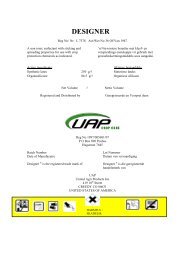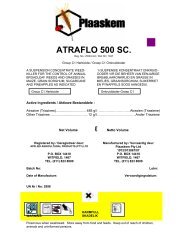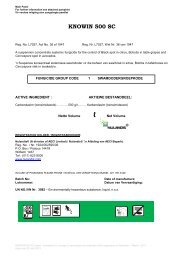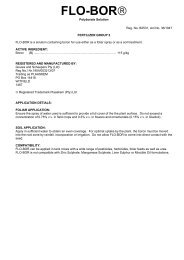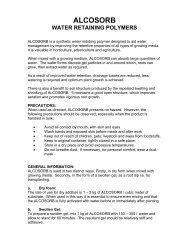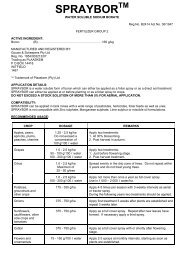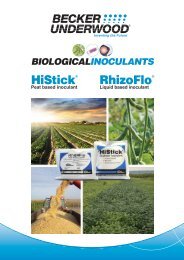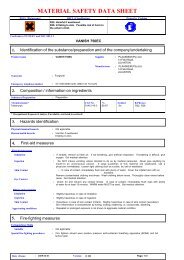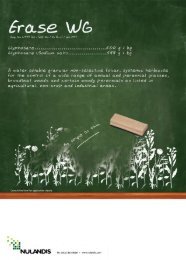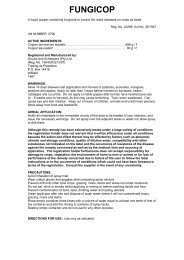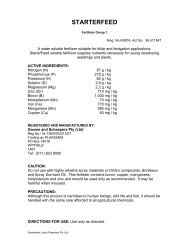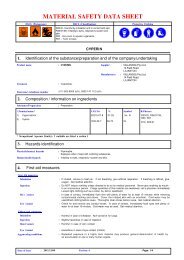CYPERIN - Nulandis
CYPERIN - Nulandis
CYPERIN - Nulandis
Create successful ePaper yourself
Turn your PDF publications into a flip-book with our unique Google optimized e-Paper software.
American bollworm resistance management:<br />
Resistance of American bollworm (Helicoverpa armigera) to synthetic pyrethroids has been<br />
confirmed.<br />
COTTON: Synthetic pyrethroids must only be applied to cotton during the period 1 January to<br />
28 February. DO NOT apply more than two applications per growing season.<br />
ALL OTHER CROPS: If a pyrethroid gives poor performance DO NOT re-spray with any<br />
synthetic pyrethroid, even at a corrective dosage rate. Use a product from a different<br />
chemical group code.<br />
DIRECTIONS FOR USE: USE ONLY AS DIRECTED<br />
Compatibility:<br />
Do not mix with seaweed extract or amitraz, chinomethionat, vamidothion, prothiophos.<br />
When spraying apples, pears and grapes a wetting agent should not be added to Cyperin.<br />
Cyperin is compatible with most cotton miticides in common use. The compatibility of<br />
Cyperin with other products may be influenced by the formulation of the products involved as<br />
well as the quality of the water. Since the formulator of other products may change and water<br />
quality may vary from farm to farm a physical compatibility test should always be carried out<br />
prior to application.<br />
Mixing Instructions:<br />
The addition of Bladbuff 7 (Reg. No. L8121) or Bladbuff 12 (Reg. No. L8201) to the spray<br />
water prior to addition of Cyperin is recommended to prevent alkaline hydrolysis. Add<br />
Bladbuff 7 or Bladbuff 12 first to the spray water. Half fill the spray tank with clean water.<br />
Add the measured amount of Cyperin to the tank while agitating. Fill the tank and maintain<br />
agitation until spraying is completed. Ensure thorough agitation during the filling of the spray<br />
tank and spraying. Prepared spray mixture must not be left in the spray tank for any length of<br />
time e.g., overnight.<br />
Ground Application:<br />
When using a conventional high volume sprayer or a mist blower, fit equipment with hollow<br />
cone nozzles that give medium to fine droplets. Ensure that sprayers are calibrated before<br />
spraying and that thorough coverage is obtained. A uniform distribution must be ensured<br />
throughout the target area. The use of drop arms on conventional booms is recommended<br />
when spraying crops such as cotton and tomatoes. Do not spray plants that are wet with dew<br />
or rain.<br />
Aerial Application:<br />
Aerial application may only be done by a registered aerial application operator using a<br />
correctly calibrated, registered aircraft according to the instructions of SANS Code 10118<br />
(Aerial Application of Agricultural Pesticides). It is important to ensure that the spray mixture<br />
is distributed evenly over the target area and that the loss of spray material during application<br />
is restricted to a minimum. It is therefore essential that the following criteria are met:<br />
Equipment:<br />
q Use suitable atomising equipment (hydraulic nozzles or rotary atomisers) that will produce<br />
the desired droplet size and coverage, but which will ensure the minimum loss of product<br />
through drift.<br />
q The operator must use a setup that will produce a droplet spectrum with the lowest<br />
possible relative span.<br />
q All nozzles / atomisers should be positioned within the inner 75 % of the wingspan to<br />
prevent droplets from entering the wingtip vortices.<br />
Cyperin to include Bladbuff 7 & 12 submitted June 2011: Approved July 2012



